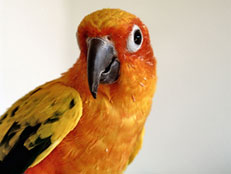
1.The “lost cousins”.
The Quaker Monk parakeet is actually a conure, due to its physical similarities to this group. However, it is classified under its own category because of unique traits that can’t be found in conures—or any other bird for that matter.
2.Urban conure colonies.
While wild conures make their home in the jungles, colonies have been found in highly populated cities like Seattle (namely, Seward Park) and San Francisco (Telegraph Hill). The latter were immortalized in the film, The Wild Parrots of Telegraph Hill.
3.Celebrity conures.
Remember the movie Paulie? The cheeky parrot who led the movies adventures (or misadventures) was a blue-crowned conure. Good thing that most of them aren’t as naughty as that!
4.Strong, silent type.
Conures aren’t really known for their ability to talk. Most of them can be taught just 5 words, though some may learn up to 50. It really depends on the bird’s personality, the owner’s patience, and the length and consistency of the training sessions.
5.Rare conures in breeding program.
The Wildlife Conservation Act once made it illegal to import wild birds, especially the rare or endangered species. However, the Fish and Wildlife Service has recently approved a “breeding consortium” which will allow expert breeders to bring them in, and hopefully increase their flagging numbers. While it’s a great idea, the breeders have run into problems with red tape. The blue throated conure and rose headed conure were never allowed out of their countries of origin, so even if they have a permit to import birds, those varieties need boxes and boxes of paperwork.
6.New conure varieties?
Richard Cusick, a member of the Breeding Consortium, has had great success in cross-breeding conures to create very beautiful and increasingly popular mutation. These include the cinnamon and yellow-sided green checks. Recently, he also had tremendous success in breeding the rare roseifrons—the first time it’s ever been done in the United States. Cuisick’s next project is a turquoise conure.
7.How much is that conure?
While most common conures can be bought for $100, the rarer varieties can really hit the bank account. For example, the blue mutations of the orange front and the dusky can fetch a stunning five thousand dollars. Start saving!
8.That’s my human!
Conures can be fiercely protective of their owners and may become jealous if another bird is brought into the household. That’s why many aficionados will keep them in separate cages. (It also makes them easier to train.)